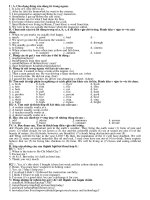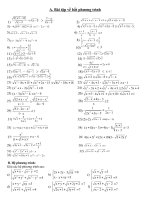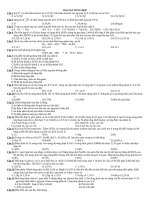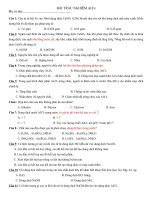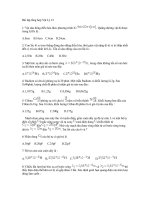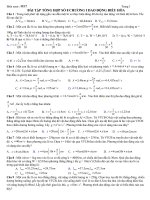- Trang chủ >>
- THPT Quốc Gia >>
- Toán
Bài tập tổng hợp
Bạn đang xem bản rút gọn của tài liệu. Xem và tải ngay bản đầy đủ của tài liệu tại đây (1.26 MB, 8 trang )
<span class='text_page_counter'>(1)</span><div class='page_container' data-page=1>
Copyrightq1996, American Society for Microbiology
<i>The pef Fimbrial Operon of Salmonella typhimurium Mediates</i>
Adhesion to Murine Small Intestine and Is Necessary for
Fluid Accumulation in the Infant Mouse
ANDREAS J. BA
ă UMLER,* RENE
´ E M. TSOLIS, FRANCES A. BOWE,† JOHANNES G. KUSTERS,‡
STEFAN HOFFMANN,
ANDFRED HEFFRON
<i>Department of Molecular Microbiology and Immunology, Oregon Health Sciences University,</i>
<i>Portland, Oregon 97201-3098</i>
Received 21 August 1995/Returned for modification 24 September 1995/Accepted 12 October 1995
<i><b>We investigated the role of the pef operon, containing the genes for plasmid-encoded (PE) fimbriae of</b></i>
<i><b>Salmonella typhimurium, in adhesion to the murine small intestine. In an organ culture model, a mutant of S.</b></i>
<i><b>typhimurium carrying a tetracycline resistance cassette inserted in pefC was found to be associated in lower</b></i>
<b>numbers with murine small intestine than the wild type. Similarly, heterologous expression of PE fimbriae in</b>
<i><b>Escherichia coli increased the bacterial numbers recovered from the intestine in the organ culture model.</b></i>
<i><b>Adhesion to villous intestine mediated by PE fimbriae was further demonstrated by binding of an E. coli strain</b></i>
<i><b>expressing PE fimbriae to thin sections of mouse small intestine. The contribution of pef-mediated adhesion on</b></i>
<i><b>fluid accumulation was investigated in infant mice. Intragastric injection of S. typhimurium 14028 and SR-11</b></i>
<i><b>caused fluid accumulation in infant mice. In contrast, pefC mutants of S. typhimurium 14028 and SR-11 were</b></i>
<i><b>negative in the infant mouse assay. Introduction of a plasmid containing pefBACD and orf5, the first five genes</b></i>
<i><b>of the pef operon, into the pefC mutant complemented for fluid accumulation in the infant mouse assay.</b></i>
<i><b>However, heterologous expression of PE fimbriae in E. coli did not result in fluid accumulation in the infant</b></i>
<b>mouse, suggesting that factors other than fimbriae are involved in causing fluid accumulation.</b>
<i>Salmonella typhimurium is the most common cause of acute</i>
gastroenteritis in humans in the United States. However, the
<i>mechanism by which S. typhimurium causes diarrhea in humans</i>
is not well defined. Although at least three different toxic
<i>activities of S. typhimurium have been found in several animal</i>
and cell culture models, their contribution to the generation of
diarrhea in humans has never been conclusively demonstrated
(3, 10, 13, 23, 24, 31, 32, 37–39, 51). In fact, salmonellosis
appears to be a complex, multifactorial process (43), and the
<i>ability of S. typhimurium to multiply in the lamina propria and</i>
cause inflammation may contribute significantly to diarrheal
disease (8, 9, 11).
Bacterial adhesins are known to support colonization of the
host’s alimentary tract, thereby increasing the bacterial load in
proximity to the epithelial lining. As a consequence, fimbriae
<i>of enterotoxigenic Escherichia coli and Vibrio cholerae are </i>
nec-essary for diarrhea (5, 14, 18, 42, 45, 46). Although several
<i>fimbrial adhesins have been found in S. typhimurium (1), </i>
fim-briae have so far not been implicated in fluid accumulation in
animal models. In this report, we present evidence that
<i>plas-mid-encoded (PE) fimbriae of S. typhimurium mediate </i>
adhe-sion to mouse small intestine and are necessary for fluid
accu-mulation in the infant mouse assay.
<b>MATERIALS AND METHODS</b>
<b>Bacterial strains, cell lines, and growth conditions.</b>Bacterial strains used in
this study are listed in Table 1. All bacteria were cultured in Luria-Bertani broth
(LB; 5 g of yeast extract, 10 g of tryptone, and 10 g of NaCl per liter) or on plates
(LB broth containing 15 g of agar per liter) at 378C. Antibiotics, when required,
were included in the culture medium or plates at the following concentrations:
carbenicillin, 100 mg/liter; kanamycin, 60 mg/liter; nalidixic acid, 50 mg/liter;
chloramphenicol, 30 mg/liter; and tetracycline, 10 mg/liter. HeLa and T84 cells
were cultivated in Dulbecco’s modified Eagle’s medium (GIBCO) supplemented
with 10% heat-inactivated fetal calf serum (GIBCO), 1% nonessential amino
acids, and 1 mM glutamine (DMEMsup). For adhesion assays, 24-well microtiter
plates were seeded with HeLa or T84 cells at a concentration of 53105<sub>cells per</sub>
well in 0.5 ml of DMEMsup and incubated overnight at 378C in 5% CO2.
Analytical-grade chemicals were purchased from Sigma. All enzymes were
pur-chased from Boehringer Mannheim.
<b>Recombinant DNA and genetic techniques.</b>Plasmid DNA was isolated by
using ion-exchange columns from Qiagen. Standard methods were used for
restriction endonuclease analyses, ligation and transformation of plasmid DNA,
transfer of plasmid DNA by conjugation, and isolation of chromosomal DNA
from bacteria (27, 30). Plasmids were constructed by using the vector pBluescript
SK1(40) or the suicide vector pEP185.2 (21).
Southern transfer of DNA onto a nylon membrane was performed as
previ-ously described (27). Labeling of DNA probes, hybridization, and immunological
detection were done by using the DNA labeling and detection kit
(nonradioac-tive) from Boehringer Mannheim. The DNA was labeled by random-primed
incorporation of digoxygenin-labeled dUTP. Hybridization was performed at
658C in solutions without formamide. Hybrids were detected by an
enzyme-linked immunoassay, using an antidigoxygenin-alkaline phosphatase conjugate
and the substrate AMPPD [3-(29-spiroademantane)-4-methoxy-4-(30
-phosphory-loxy)phenyl-1,2-dioxethane; Boehringer Mannheim]. The light emitted by the
dephosphorylated AMPPD was detected by X-ray film.
<b>Production of rabbit anti-PefA serum.</b>The nucleotide sequence of a DNA
region encoding PE fimbriae which has been reported recently (7) was used to
<i>design primers for PCR amplification of pefA. A DNA fragment encoding the</i>
C-terminal 167 amino acids of PefA was amplified by using the primers 59
-GGGAATTCTTGCTTCCATTATTGCACTGGG-39 and 59-TCTGTCGACG
GGGGATTATTTGTAAGCCACT-39. The 520-bp PCR product was digested
<i>with EcoRI and SalI and cloned into the expression vector pGEX-4T-1 to create</i>
<i>an in-frame translational fusion with the N terminus of gluthathione </i>
<i>trans-ferase and amino acids 6 to 172 of PefA. Purification of the glutathione </i>
S-transferase–PefA fusion protein from sonic lysates was performed by using a
gluthathione-Sepharose affinity matrix (Pharmacia). The purified fusion protein
was used to produce antiserum by injecting a rabbit subcutaneously at six
dif-* Corresponding author. Mailing address: Department of Molecular
Microbiology and Immunology, Oregon Health Sciences University,
3181 SW Sam Jackson Park Road, L220, Portland, OR 97201-3098.
Phone: (503) 494-6841. Fax: (503) 494-6862.
† Present address: Department of Biochemistry, Imperial College,
London SW7 2AZ, England.
‡ Present address: Department of Medical Microbiology, Vrije
Uni-versiteit, 1081 BT Amsterdam, The Netherlands.
</div>
<span class='text_page_counter'>(2)</span><div class='page_container' data-page=2>
ferent locations with a total of 1 mg of fusion protein suspended in Titermax
adjuvant (Cytrx). A booster injection was administered 4 weeks later.
<b>Electron microscopy.</b>Bacteria were grown overnight in a static culture and
were allowed to adhere to a Formvar-coated grid for 2 min. The bacteria were
fixed with 0.1% glutaraldehyde in sodium cacodylate buffer (100 mM, [pH 7.4])
for 1 min. The grid was rinsed with water, and fimbriae were negatively stained
with 0.5% (wt/vol) aqueous uranyl acetate (pH 4.6) for 30 s. The grids were
allowed to dry before they were analyzed by electron microscopy.
<b>Virulence studies in mice.</b><i>Virulence of S. typhimurium mutants was tested by</i>
infection of 6- to 8-week-old female BALB/c mice. To calculate the 50% lethal
dose (LD50), serial 10-fold dilutions of overnight cultures were made in LB and
administered intragastrically to groups of four mice in a 0.2-ml volume. Mortality
was recorded at 4 weeks postinfection, and the LD50was calculated by the
method of Reed and Muench (35).
<b>Ligated ileal loop model.</b>Ligated intestinal loops were prepared as described
previously (17), using 6- to 8-week-old female BALB/c mice. In brief, mice were
starved for 24 h prior to intraperitoneal injection of 1.5 to 2 mg of Nembutal
(Abbott Laboratories, North Chicago, Ill.) per mouse. A small incision was then
made through the abdominal wall, and the small bowel was exposed. A loop was
formed by ligating the intestine with silk thread at the ileocecal junction and at
a site;4 to 5 cm proximal to the cecum. Bacteria (200 ml of a 53109<sub>-CFU/ml</sub>
culture) were injected through a 25-gauge needle. The bowel was then returned
to the abdomen, and the incision was stapled closed. Mice were killed after 8 h
by cervical dislocation, and fluid accumulation in intestinal loops was evaluated.
<b>Cell culture techniques and adhesion assay.</b>HeLa and T84 cells were fixed in
2% glutaraldehyde in phosphate-buffered saline (PBS) for 1 h at 48C.
Glutaral-dehyde was removed by three 30-min washes with 1 ml of PBS at 48C, and 1 ml
of DMEMsup was added to each well. The bacterial cultures were diluted, and
about 53106<sub>bacteria in 0.25 ml of DMEMsup were added to each well. Both</sub>
1 and 2 h after incubation at 258C, nonadherent bacteria were removed by five
washes with 1 ml of PBS. Wells were sampled by lysing the fixed cells with 0.5 ml
of 1% deoxycholate and rinsing each well with 0.5 ml of PBS. Adherent bacteria
were quantified by plating dilutions made in sterile PBS on LB agar. All
exper-iments were performed independently three times.
<b>IOC.</b>On the basis of the conditions described for tissue preservation (50), we
established an intestinal organ culture model (IOC) which allowed us to study
association of salmonellae to the lumen of the small bowel in vitro. In brief,
bacteria were grown as standing overnight cultures in 1 ml of LB at 378C in 5%
CO2, harvested, and resuspended in DMEMsup. The small intestines were
re-moved from 8-week-old female BALB/c mice, starved for 24 h prior to the
experiment, and placed into a petri dish containing DMEMsup. The intestine
(;20 cm) was ligated at the distal end, filled with 1 ml of a bacterial suspension
containing 109
CFU, then ligated at the proximal end, and incubated for 30 min
at 378C in 5% CO2. The intestine was opened at both ends, rinsed with 1 ml of
PBS, and opened longitudinally. Nonadherent bacteria were removed by three
washes in 10 ml of PBS in petri dishes, and 3-cm sections of intestinal wall were
homogenized in 5 ml of PBS, using a Stomacher (Tekmar, Cincinnati, Ohio).
Dilutions were plated on LB containing the appropriate antibiotics to quantify
the bacteria associated with the organ. Experiments were repeated with organs
from six different animals. A paired difference test was used to evaluate the
significance of differences in adhesion observed for different strains.
<b>In vitro adhesion assay to thin sections from mouse small intestine.</b>Six- to
eight-week-old female BALB/c mice were anesthetized with Avertin (2.5%, 0.03
ml/g of body weight). For perfusion with picric acid-paraformaldehyde (2%
paraformaldehyde, 15% picric acid, 0.1 M monobasic sodium phosphate [pH
7.3]), the thoracic cavity was opened, and a perfusion needle, pressured by a
peristaltic pump (Pharmacia model P-1), was inserted into the left ventricle.
After flow of saline solution into heart had begun, the atria were cut, allowing
blood to exit. Perfusion with saline was followed by perfusion with picric
acid-paraformaldehyde. The mouse small intestine was then removed and fixed in
picric acid-paraformaldehyde for 2 h. The tissue was washed with PBS and
allowed to stand in 10% sucrose–PBS for 4 h. Tissues were immersed in OCT
embedding medium (Tissue-Tek, Miles Scientific) in a mold and quick-frozen in
a liquid nitrogen-cooled bath of 2-methyl butane, and 10-mm histological
sec-tions were placed on microscope slides. Nonspecific binding to secsec-tions was
blocked by a 30-min incubation in 0.05% Tween 20–0.2% bovine serum albumin
in PBS at 378C. Bacteria were labeled with fluorescein isothiocyanate (Sigma) as
described previously (36). Fluorescein isothiocyanate-labeled bacteria were
di-luted in PBS containing 0.01% (vol/vol) Tween 20. A few drops of this suspension
were placed directly over the tissue specimen, which was then incubated at 378C
in a moist chamber. After 30 min, nonadherent bacteria were removed by six
5-min changes in PBS, and the sections were fixed for 10 min on ice in 3%
paraformaldehyde. The slides were mounted in slow-fade mounting medium
(Molecular Probes Inc.) and examined by fluorescence microscopy. Adhesion
was performed for each strain on three slides, carrying at least four specimens,
in parallel. Each experiment was repeated three times with tissues from different
animals, and adhesion was evaluated by two different persons independently.
<b>Infant suckling mouse model.</b> The infant suckling mouse assay has been
<i>described previously (4) and has been modified for S. typhimurium by Koupal and</i>
Deibel (24). In brief, bacteria were grown in LB to an optical density at 578 nm
of between 1.0 and 1.5, harvested by centrifugation, and resuspended in an equal
volume of sterile PBS. The inoculum contained between 23107<sub>and 5</sub><sub>3</sub><sub>10</sub>7
bacteria, as determined by performing colony counts. Groups of four 3- to
5-day-old mice were injected intragastrically with 0.1 ml of bacterial suspension.
After 2.5 h, the alimentary tract was removed, and the ratio between intestinal
weight and the weight of the remaining body was determined for each mouse.
For each bacterial strain, the mean of these ratios from at least four different
mice was calculated, and the significance of differences observed was analyzed by
<i>Student’s t test. If the mean of a ratio was significantly greater than that of the</i>
<i>PBS control (P</i>,0.025), it was scored positive. The values obtained were always
consistent with the apparent fluid accumulation observed during removal of the
mouse alimentary tract.
<b>RESULTS</b>
<i><b>Cloning and analysis of cosmids containing the S. </b></i>
<i><b>typhi-murium pef operon.</b></i>
<i>The PCR product containing pefA was</i>
<i>used as a probe to screen for cosmids containing the pef operon</i>
<i>by colony hybridization of a S. typhimurium gene bank </i>
con-structed in pLAFR II (25). Cosmids which gave positive
hy-bridization signals were isolated from 10 colonies and
desig-nated pFB1, pFB2, pFB4, pFB5, pFB6, pFB7, pFB8, pFB9,
<i>pFB10, and pFB11. The cosmids and the S. typhimurium </i>
viru-14028rck <i>14028 rck::Km</i>r <sub>D. Guiney</sub>
SR-11 Wild type Laboratory collection
x4252 SR-11D<i>[ahp-11::Tn10]-251</i> 26
x4253 SR-11D<i>[fim-ahp-11::Tn10]-391</i> 26
AJB9 SR-11D<i>[ahp-11::Tn10]-251, pefC::Tet</i>r<sub>Nal</sub>r <sub>This study</sub>
<i>S. enteritidis</i> 1
<i>S. dublin</i> 1
</div>
<span class='text_page_counter'>(3)</span><div class='page_container' data-page=3>
<i>lence plasmid were digested with EcoRI, SalI, and EcoRI-SalI,</i>
and the restriction patterns were compared with those
<i>re-ported for the pef operon and the S. typhimurium virulence</i>
<i>plasmid (Fig. 1) (7, 48). Restriction fragments from an </i>
<i>EcoRI-SalI digest were transferred onto nylon membranes and </i>
<i>hy-bridized, using the pefA PCR product as a probe. The virulence</i>
plasmid and cosmids pFB1, pFB2, pFB4, pFB8, pFB10, and
<i>pFB11 contained a 2.4-kb EcoRI-SalI fragment which </i>
<i>hybrid-ized with the pefA probe. Hybridization with the pefA probe</i>
<i>identified EcoRI-SalI restriction fragments of 2 kb (pFB6), 1.7</i>
kb (pFB7), and 1.6 kb (pFB5 and pFB9), which indicated that
<i>the EcoRI-SalI fragments are located on one end of the insert</i>
in the corresponding cosmids (Fig. 1). Comparison of cosmid
restriction patterns and analysis of data obtained by
<i>hybridiza-tion with the pefA probe enabled the approximate localizahybridiza-tion</i>
of these cosmids on the virulence plasmid to be determined
(Fig. 1).
<i><b>Expression of PE fimbriae in E. coli.</b></i>
Expression of PE
<i>fim-briae from the pef operon has previously been demonstrated in</i>
<i>E. coli and S. typhimurium (7). We investigated whether all</i>
<i>cosmids cloned by hybridization with the pefA probe mediated</i>
<i>expression of PE fimbriae in E. coli. For this purpose, cosmids</i>
<i>were introduced into a nonfimbriated E. coli strain (ORN172)</i>
(49), and expression of PefA was investigated by Western
blot-ting (immunoblotblot-ting) with rabbit anti-PefA serum. A band of
17 kDa was detected in strains carrying cosmid pFB1, pFB2,
pFB4, pFB8, pFB10, or pFB11 but not in strains carrying
cosmid pFB6, pFB7, pFB5, pFB9, or pLAFR II (Fig. 1 and 2).
These results were confirmed by transmission electron
micros-copy of negatively stained bacteria. Again, only strains carrying
cosmid pFB1, pFB2, pFB4, pFB8, pFB10, or pFB11 were
<i>fim-briated (Fig. 3). These data indicated that the 2.4-kb </i>
<i>EcoRI-SalI fragment contains upstream DNA sequences necessary for</i>
<i>pef expression (Fig. 1).</i>
<i><b>Construction of a pefC insertional mutant of S. typhimurium.</b></i>
In other fimbrial operons, mutations in genes encoding
assem-bly proteins have always resulted in absence of adhesins from
<i>the bacterial surface. The gene product of pefC has homology</i>
to fimbrial outer membrane ushers (7). To inactivate this gene,
<i>a 1,403-bp DNA fragment of the pefC open reading frame was</i>
amplified by using the primers 5
9
-AAGAATCAGCAAATG
CCCTGTG-3
9
and 5
9
-GCGAATTCTAAAGGAGAGCGAC
GTG-3
9
<i>. The PCR product was digested with EcoRI and </i>
<i>li-gated into the vector pBluescript digested with EcoRI-SmaI.</i>
<i>The resulting plasmid, pPE1, was digested with SmaI, thereby</i>
<i>deleting 374 bp of the pefC gene, and the 2-kb SmaI fragment</i>
carrying the tetracycline resistance gene of pAK1900 (34a) was
ligated into this site. From the resulting plasmid, pPE2, a
<i>KpnI-XbaI fragment was cloned into the suicide vector</i>
<i>pEP185.2 (21). This construct (pPE3) was introduced into E.</i>
<i>coli S17</i>
l
<i>pir and then conjugated into S. typhimurium IR715</i>
(44). One exconjugant sensitive to chloramphenicol (vector)
and resistant to tetracycline was designated AJB7.
Chromo-somal DNA of AJB7 was analyzed by Southern hybridization
<i>with the pefA probe to confirm insertional inactivation of pefC</i>
(Fig. 4).
<i><b>Influence of PE fimbriae on adhesion of E. coli and S. </b></i>
<i><b>typhi-murium to murine small intestine in vitro.</b></i>
We next
<i>investi-gated whether the pef operon is involved in adhesion to </i>
epi-thelial cells in vitro. No difference in adhesion between IR715
and AJB7 or between ORN172 and ORN172(pFB11) was
ob-served when we used HeLa and T84 cells, two human epithelial
<i>cell lines (data not shown). We next studied the effect of a pefC</i>
mutation on adhesion in an IOC. The work by Worton et al.
has established that the intestinal epithelium remains intact for
up to 2 h if sections of murine small bowel are placed into
tissue culture medium (50). The IOC allowed us to restrict
bacterial contact to the luminal surface of the intestine. The
influence of variations between animals on the IOC was
min-imized by performing mixed infection experiments. When a 1:1
mixture of IR715 and AJB7 was used as the inoculum, IR715
was found to be associated in larger numbers with sections of
<i>the small intestine than the pefC mutant AJB7 (P</i>
,
0.005)
(Fig. 5). We next investigated whether heterologous expression
<i>of PE fimbriae in E. coli confers increased adhesion to murine</i>
<i>FIG. 1. Restriction map of a region from the S. typhimurium virulence plasmid (7, 48). Positions of open reading frames identified previously (7) are shown as</i>
outlined arrows above the map. Locations of inserts from cosmids used in this study are shown below. Dashed lines indicate that the exact endpoint of the cosmid insert
<i>was not determined. Black bars indicate the SalI-EcoRI fragment hybridizing with a pefA DNA probe. Results from Western blotting with a rabbit anti-PefA serum</i>
<i>of E. coli strains harboring these cosmids are shown on the left.</i>1, signal with anti-PefA serum;2<i>, no signal with anti-PefA serum. S, SalI; E, EcoRI.</i>
</div>
<span class='text_page_counter'>(4)</span><div class='page_container' data-page=4>
intestine. To this end, a 1:1 mixture of cultures from ORN172
and ORN172(pFB11) was used as an inoculum in the IOC.
Larger numbers of ORN172(pFB11) than of ORN172 were
<i>recovered from villous intestine (P</i>
,
0.05) (Fig. 5). These data
<i>are consistent with a role of the pef operon in adhesion to the</i>
lining of the small intestine.
To confirm the results obtained with the IOC visually, we
analyzed bacterial adhesion to thin sections from murine
vil-lous intestine with fluorescence microscopy. However, because
of strong background binding, we were unable to observe
dif-ferences in adhesion to these specimen between IR715 and
AJB7 (data not shown). A possible reason for the observed
<i>strong binding of S. typhimurium may be the fact that this</i>
serotype expresses at least six different fimbriae (1). We
there-fore investigated adhesion mediated by PE fimbriae in a
<i>bet-ter-defined E. coli strain background. The nonfimbriated E.</i>
<i>coli strain ORN172 bound poorly to sections of villous </i>
intes-tine (Fig. 6). In contrast, strain ORN172(pFB11) expressing
PE fimbriae adhered in increased numbers to villous intestine.
<i>These data thus provide further evidence for a role of the pef</i>
operon in bacterial adhesion to murine small intestine.
<i><b>Virulence of strains carrying pefC mutations in mice.</b></i>
The
virulence of AJB7 in mice was compared with that of the wild
type (IR715) by determining the LD
50after intragastric
injec-tion. The LD
50of AJB7 was found to be 1.4
3
10
6
<sub>, while that</sub>
of IR715 was 6
3
10
5<sub>. These data indicate that expression of</sub>
PE fimbriae plays only a minor role, if any, during murine
typhoid fever. This is consistent with earlier reports, in which
<i>plasmid cured derivatives of S. typhimurium could be </i>
<i>comple-mented to nearly wild type virulence by introduction of the spv</i>
operon on a plasmid (12).
<i>FIG. 3. Transmission electron micrograph of E. coli ORN172(pFB6) (A) and ORN172(pFB11) (B). Bars indicate 1</i>mm.
<i>FIG. 4. Southern hybridizations of chromosomal DNA digested with </i>
<i>Hin-dIII-EcoRI with a pefA DNA probe. Positions of DNA fragments with known</i>
sizes are given at the right. Chromosomal DNA originated from strains indicated
above the lanes.
</div>
<span class='text_page_counter'>(5)</span><div class='page_container' data-page=5>
<b>Role of PE fimbriae in induction of fluid accumulation in</b>
<b>the infant mouse.</b>
<i>The enteric fever caused by S. typhimurium</i>
in mice is thought to closely resemble human typhoid, a disease
<i>caused by Salmonella typhi in humans. Murine typhoid fever,</i>
<i>however, does not mimic the acute gastroenteritis caused by S.</i>
<i>typhimurium in humans (9). Instead, several cell culture and</i>
animal models have been used to study the various activities
</div>
<span class='text_page_counter'>(6)</span><div class='page_container' data-page=6>
loops infected with IR715 clearly showed fluid accumulation,
14028P
2and the PBS control did not. We further studied the
<i>role of the pef operon in fluid accumulation in the infant</i>
<i>suckling mouse assay (24). While the S. typhimurium wild-type</i>
strains IR715 and SR-11 caused significant fluid accumulation
<i>in infant mice compared with the PBS control (P</i>
,
0.025),
<i>infection with derivatives carrying a pefC mutation (AJB7 and</i>
AJB9) did not produce this effect (Table 2). In contrast, a
<i>mutation in rck, a gene located downstream of the pef operon,</i>
<i>did not abolish fluid accumulation (P</i>
,
0.005) (Table 2). The
<i>pefC mutant AJB7 could be complemented for fluid </i>
accumu-lation by introduction of plasmid p22.2, containing the genes
<i>pefBACD and orf5 (P</i>
,
0.005) (7). By transposon mutagenesis,
all five genes present on plasmid p22.2 have been shown to be
necessary for surface presentation of PE fimbriae (7).
Further-more, fluid accumulation could be observed after infection
<i>with a plasmidless S. typhimurium strain containing a cosmid</i>
<i>carrying the entire pef operon (pFB11) but not with a strain</i>
<i>containing a cosmid carrying a truncated pef promoter region</i>
<i>(pFB6) (Table 2). Introduction of pFB11 into the E. coli</i>
ORN172, however, did not result in fluid accumulation. These
<i>results indicate that expression of the pef operon is necessary</i>
for, but is not the only factor involved in, fluid accumulation in
infant mice. To determine the contribution of type 1 fimbriae
<i>to fluid accumulation, we tested an S. typhimurium fim mutant</i>
<i>in the infant mouse assay. A deletion of the S. typhimurium fim</i>
operon did not decrease fluid accumulation.
<b>DISCUSSION</b>
In this report, we demonstrate that PE fimbriae mediate
adhesion to murine small intestine. Mutational inactivation of
<i>pefC resulted in only a moderate decrease in mouse virulence</i>
<i>of S. typhimurium, indicating that pef-mediated adhesion to</i>
murine small intestine is not essential for murine typhoid. Thus
far, the contribution of two fimbrial adhesins during infection
of mice has been studied by mutational analysis (2, 26). Loss of
<i>genes encoding type 1 fimbriae increases the virulence of S.</i>
<i>typhimurium for mice about 10-fold (26). In contrast, LP </i>
fim-briae mediate adhesion to murine Peyer’s patches and are
necessary for full virulence in murine typhoid (2). These data
therefore suggested that PE fimbriae serve a function distinct
<i>from that described for other S. typhimurium adhesins. Thus,</i>
bacterial adhesion can have different consequences during
<i>ex-perimental infection of mice with S. typhimurium.</i>
Using infant mice, we show that PE fimbriae are necessary
<i>for fluid accumulation mediated by S. typhimurium. However,</i>
<i>although PE fimbriae mediated adhesion of E. coli to mouse</i>
<i>small intestine, the pef operon did not mediate fluid </i>
<i>accumu-lation. This result is consistent with the idea that the pef operon</i>
<i>acts in concert with additional factors encoded on the </i>
<i>Salmo-nella chromosome to cause fluid accumulation in the infant</i>
suckling mouse assay. Among the possible factors involved in
<i>fluid accumulation are several toxic activities found in S. </i>
<i>typhi-murium (3, 10, 13, 23, 24, 31, 32, 37–39, 51). However, these</i>
toxins have never been purified, and genes encoding these toxic
activities have never been studied by mutational inactivation. A
second possible diarrheagenic principle was suggested by
Gi-annella and coworkers, who provided convincing evidence that
inflammation contributes to fluid accumulation in rabbit
li-gated ileal loops (8, 9, 11). Recently, McCormick et al.
estab-lished a cell culture model for the transepithelial migration of
<i>neutrophils induced by S. typhimurium (28, 29). Interestingly,</i>
<i>the neutrophil transmigration response required adhesion of S.</i>
<i>typhimurium to the epithelial apical membrane and subsequent</i>
reciprocal protein synthesis in both bacteria and epithelial
<i>cells. Adhesion of E. coli to epithelial cells did not result in</i>
transepithelial neutrophil migration. Thus, adhesins may act in
<i>concert with S. typhimurium factors, eliciting epithelial </i>
re-sponses which lead to inflammation. These data are therefore
in agreement with a role of PE fimbriae in fluid accumulation
by mediating adhesion to murine intestinal epithelial cells.
Binding of fimbriae to receptors which are present only in
certain species can contribute to determining the host range of
enteric pathogens (5, 6, 16, 19, 22, 33, 47). Therefore, our
results do not imply that PE fimbriae are necessary for
diar-rhea in humans. In fact, PE fimbriae may only mediate
colo-nization of the mouse small intestine, and their contribution to
fluid accumulation in infant mice does not allow conclusions as
to their role in other host species. For example, we show that
<i>adhesion of S. typhimurium to the human intestinal epithelial</i>
cell line T84 is not mediated by PE fimbriae. McCormick et al.
used polarized T84 cells in their model for induction of
<i>trans-epithelial migration of neutrophils by S. typhimurium (28).</i>
Thus, it is unlikely that PE fimbriae would contribute to
trans-epithelial neutrophil migration in this model. Similarly, PE
fimbriae do not contribute to fluid accumulation in rabbit
li-gated ileal loops (15). It is likely that adhesins other than PE
fimbriae contribute to transepithelial neutrophil migration or
6 2
<i>E. coli</i>
ORN172 Nonpiliated 0.07760.009 2
ORN172(pFB11) <i>pef operon on cosmid</i> 0.08760.011 2
PBS 0.09660.007 2
<i>a</i><sub>Mean of the ratios between weight of mouse intestine and rest of the body from at least four different animals</sub><sub>6</sub><sub>standard error.</sub>
</div>
<span class='text_page_counter'>(7)</span><div class='page_container' data-page=7>
fluid accumulation in these models. The comparison with
mod-els for salmonellosis is further complicated by the observation
that the mouse strain used can influence results obtained in the
infant suckling mouse assay (42a). This may be the reason why
studies using infant Swiss mice did not observe
<i>enteropatho-genicity of S. typhimurium strains (20, 34). Therefore, the use</i>
of BALB/c mice may be recommended for future studies using
this animal model.
<b>ACKNOWLEDGMENTS</b>
We thank R. Curtiss III, S. Libby, D. Guiney, R. Kadner, and P.
Orndorff for kindly providing bacterial strains, K. Poole for providing
plasmids and sharing unpublished results, P. Stenberg and R. Jones for
performing electron microscopy, and P. Valentine, S. Lindgren, and I.
Stojiljkovic for critical comments on the manuscript.
This work was supported by NIH grant ROI AI 22933 to F. Heffron.
J. Kusters was supported by a fellowship from the Royal Netherlands
Academy of Arts and Sciences.
<b>REFERENCES</b>
<b>1. Baăumler, A. J., and F. Heffron.</b>1995. Identification and sequence analysis of
<i>lpfABCDE, a putative fimbrial operon of Salmonella typhimurium. J. </i>
<b>Bacte-riol. 177:20872097.</b>
<b>2. Baăumler, A. J., R. M. Tsolis, and F. Heffron.</b><i>The lpf fimbrial operon </i>
medi-ates adhesion to murine Peyer’s patches. Proc. Natl. Acad. Sci. USA, in
press.
<b>3. Chopra, A. K., C. W. Houston, J. W. Peterson, R. Prasad, and J. J. </b>
<b>Mek-alanos.</b><i>1987. Cloning and expression of the Salmonella enterotoxin gene. J.</i>
<b>Bacteriol. 169:5095–5100.</b>
<b>4. Dean, A. G., Y. C. Ching, R. G. Williams, and L. B. Harden. 1972. Test for</b>
<i>Escherichia coli enterotoxin using infant mice: application in a study of</i>
<b>diarrhea in children in Honolulu. J. Infect. Dis. 125:407–411.</b>
<b>5. Evans, D. G., and D. J. Evans. 1978. New surface-associated heat-labile</b>
<i>colonization factor antigen (CFA/II) produced by enterotoxic Escherichia</i>
<i><b>coli of serogroups O6 and O8. Infect. Immun. 21:638–647.</b></i>
<b>6. Evans, D. G., R. P. Silver, D. J. Evans, D. G. Chase, and S. L. Gorbach. 1975.</b>
<i>Plasmid-controlled colonization factor associated with virulence in </i>
<i><b>Esche-richia coli enterotoxigenic for humans. Infect. Immun. 12:656–667.</b></i>
<b>7. Friedrich, M. J., N. E. Kinsey, J. Vila, and R. J. Kadner. 1993. Nucleotide</b>
<i>sequence of a 13.9 kb segment of the 90 kb virulence plasmid of Salmonella</i>
<i>typhimurium: the presence of fimbrial biosynthetic genes. Mol. Microbiol.</i>
<b>8:</b>543–558.
<b>8. Giannella, R. A. 1979. Importance of the intestinal inflammatory reaction in</b>
<i><b>Salmonella-mediated intestinal secretion. Infect. Immun. 23:140–145.</b></i>
<b>9. Giannella, R. A., S. B. Formal, G. J. Dammin, and H. Collins. 1973. </b>
Patho-genesis of salmonellosis: studies on fluid secretion, and morphologic reaction
<b>in the rabbit ileum. J. Clin. Invest. 52:441–453.</b>
<b>10. Giannella, R. A., R. E. Gots, A. N. Charney, W. B. Greenough, and S. B.</b>
<b>Formal.</b>1975. Pathogenesis of Salmonella-mediated intestinal fluid
<b>secre-tion. Gastroenterology 69:1238–1245.</b>
<b>11. Gots, R. E., S. B. Formal, and R. A. Giannella. 1974. Indomethacin inhibition</b>
<i>of Salmonella typhimurium, Shigella flexneri, and cholera-mediated rabbit</i>
<b>ileal secretion. J. Infect. Dis. 130:280–284.</b>
<b>12. Gulig, P. A., A. L. Caldwell, and V. A. Chiodo. 1992. Identification, genetic</b>
<i>analysis and DNA sequence of a 7.8 kb virulence region of the Salmonella</i>
<i><b>typhimurium virulence plasmid. Mol. Microbiol. 6:1395–1411.</b></i>
<b>13. Hale, T. L., and S. B. Formal. 1981. Protein synthesis in HeLa or Henle 407</b>
<i>cells infected with Shigella dysenteriae 1, Shigella flexneri 2a, or Salmonella</i>
<i><b>typhimurium W118. Infect. Immun. 32:137–144.</b></i>
<b>14. Herrington, D. A., R. H. Hall, G. Losonsky, J. J. Mekalanos, R. K. Taylor,</b>
<b>and M. M. Levine.</b>1988. Toxin, toxin coregulated pili and toxR regulon are
<i><b>essential for Vibrio cholerae pathogenesis in humans. J. Exp. Med. 168:1487–</b></i>
1492.
<b>15. Horiuchi, S., N. Goto, Y. Inagaki, and R. Nakaya. 1991. The 106-kilobase</b>
<i>plasmid of Salmonella braenderup and the 100-kilobase plasmid of </i>
<i>Salmo-nella typhimurium are not necessary for the pathogenicity in experimental</i>
<b>models. Microbiol. Immunol. 35:187–198.</b>
<b>16. Isaacson, R. E., B. Nagy, and H. W. Moon. 1977. Colonization of porcine</b>
<i>small intestine by Escherichia coli: colonization and adhesion factors in pig</i>
<b>enteropathogens that lack K88. J. Infect. Dis. 135:531–539.</b>
<i><b>17. Jones, B. D., N. Ghori, and S. Falkow. 1994. Salmonella typhimurium initiates</b></i>
murine infection by penetrating and destroying the specialized epithelial M
<b>cells of the Peyer’s patches. J. Exp. Med. 180:15–23.</b>
<b>18. Jones, G. W., and J. M. Rutter. 1972. Role of the K88 antigen in the</b>
<i>pathogenesis of neonatal diarrhea caused by Escherichia coli in piglets.</i>
<b>Infect. Immun. 6:918–927.</b>
<b>19. Jones, G. W., and J. M. Rutter. 1974. The association of K88 with </b>
<i>haemag-glutinating activity in porcine strains of Escherichia coli. J. Gen. Microbiol.</i>
<b>84:</b>135–144.
<b>20. Kaura, Y. K., V. K. Sharma, and N. K. Chandiramani. 1982. </b>
<i>Enterotoxige-nicity and invasiveness of Salmonella species. Antonie van Leeuwenhoek</i>
<b>48:</b>273–283.
<b>21. Kinder, S. A., J. L. Badger, G. O. Bryant, J. C. Pepe, and V. L. Miller. 1993.</b>
<i>Cloning of the YenI restriction endonuclease and methyltransferase from</i>
<i>Yersinia enterocolitica serotype O:8 and construction of a transformable</i>
R2M1<b>mutant. Gene 136:271–275.</b>
<b>22. Knutton, S., D. R. Lloyd, D. C. A. Candy, and A. S. McNeish. 1984. In vitro</b>
<i>adhesion of enterotoxigenic Escherichia coli to human intestinal epithelial</i>
<b>cells from mucosal biopsies. Infect. Immun. 44:514–518.</b>
<b>23. Koo, F. C. W., J. W. Peterson, C. W. Houston, and N. C. Molina. 1984.</b>
Pathogenesis of experimental salmonellosis: inhibition of protein synthesis
<b>by cytotoxin. Infect. Immun. 43:93–100.</b>
<b>24. Koupal, L. R., and R. H. Deibel. 1975. Assay, characterization, and </b>
<i><b>localiza-tion of an enterotoxin produced by Salmonella. Infect. Immun. 11:14–22.</b></i>
<b>25. Libby, S. J., W. Goebel, A. Ludwig, N. Buchmeier, F. Bowe, F. C. Fang, D. G.</b>
<b>Guiney, J. G. Songer, and F. Heffron.</b><i>1994. A cytolysin encoded by </i>
<i>Salmo-nella is required for survival within macrophages. Proc. Natl. Acad. Sci. USA</i>
<b>91:</b>489–493.
<b>26. Lockman, H. A., and R. Curtiss III. 1992. Virulence of non-type 1-fimbriated</b>
<i>and nonfimbriated nonflagellated Salmonella typhimurium mutants in </i>
<b>mu-rine typhoid fever. Infect. Immun. 60:491–496.</b>
<b>27. Maniatis, T., J. Sambrook, and E. F. Fritsch. 1989. Molecular cloning: a</b>
laboratory manual, 2nd ed. Cold Spring Harbor Laboratory Press, Cold
Spring Harbor, N.Y.
<b>28. McCormick, B., S. P. Colgan, C. Delp-Archer, S. I. Miller, and J. L. Madara.</b>
<i>1993. Salmonella typhimurium attachment to human intestinal epithelial</i>
monolayers: transepithehlial signalling to subepithelial neutrophils. J. Cell
<b>Biol. 123:895–907.</b>
<b>29. McCormick, B. A., S. I. Miller, D. Carnes, and J. L. Madara. 1995. </b>
Trans-epithelial signaling to neutrophils by salmonellae: a novel virulence
<b>mecha-nism for gastroenteritis. Infect. Immun. 63:2302–2309.</b>
<b>30. Miller, J. H. 1972. Experiments in molecular genetics. Cold Spring Harbor</b>
Laboratory Press, Cold Spring Harbor, N.Y.
<b>31. Molina, N. C., and J. W. Peterson. 1980. Cholera toxin-like toxin released by</b>
<i><b>Salmonella species in the presence of mitomycin C. Infect. Immun. 30:224–</b></i>
230.
<b>32. O’Brien, A. D., G. D. LaVeck, M. R. Thompson, and S. B. Formal. 1982.</b>
<i>Production of Shigella dysenteriae type 1-like cytotoxin by Escherichia coli. J.</i>
<b>Infect. Dis. 146:763–769.</b>
<b>33. Ørskov, I., F. Ørskov, H. W. Smith, and W. J. Sojka. 1975. The establishment</b>
<i>of K99, a thermolabile, transmissible Escherichia coli K antigen, previously</i>
called ‘‘Kco’’, possessed by calf and lamb enteropathogenic strains. Acta
<b>Pathol. Microbiol. Scand. 83:31–36.</b>
<b>34. Panhotra, B. R., J. Mahanta, and K. C. Agarwal. 1981. Enteropathogenicity</b>
<i><b>of Salmonella typhimurium. Indian J. Med. Res. 73:847–852.</b></i>
<b>34a.Poole, K. Unpublished data.</b>
<b>35. Reed, L. J., and H. Muench. 1938. A simple method for estimating fifty</b>
<b>percent endpoints. Am. J. Hyg. 27:493–497.</b>
<b>36. Rozdzinski, E., and E. Tuomanen. 1994. Interactions of bacteria with </b>
<b>leu-kocyte integrins. Methods Enzymol. 236:333–345.</b>
<b>37. Sandefur, P. D., and J. W. Peterson. 1976. Isolation of skin permeability</b>
<i>factors from culture filtrates of Salmonella typhimurium. Infect. Immun.</i>
<b>14:</b>671–679.
<i><b>38. Sandefur, P. D., and J. W. Peterson. 1977. Neutralization of Salmonella</b></i>
toxin-induced elongation of Chinese hamster ovary cells by cholera antitoxin.
<b>Infect. Immun. 15:988–992.</b>
<b>39. Sedlock, D. M., L. R. Koupal, and R. H. Deibel. 1977. Production and partial</b>
<i><b>purification of Salmonella enterotoxin. Infect. Immun. 20:375–380.</b></i>
<b>40. Short, J. M., J. M. Fernandez, J. A. Sorge, and W. D. Huse. 1988. IZAP: a</b>
bacteriophage expression vector with in vivo excision properties. Nucleic
<b>Acids Res. 16:7583–7600.</b>
<b>41. Simon, R., U. Priefer, and A. Puhler. 1983. A broad host range mobilization</b>
system for in vivo genetic engineering: transposon mutagenesis in
<b>Gram-negative bacteria. Bio/Technology 1:784–791.</b>
<b>42. Smith, H. W., and M. A. Linggood. 1971. Observation on the pathogenic</b>
<i>properties of the K88, Hly, and Ent plasmids of Escherichia coli with </i>
<b>partic-ular reference to porcine diarrhoea. J. Med. Microbiol. 4:467.</b>
<b>42a.So, M. Y. H. Personal communication.</b>
<b>43. Stephen, J., T. S. Wallis, W. G. Starkey, D. C. A. Candy, M. P. Osborne, and</b>
<b>S. Haddon.</b><i>1985. Salmonellosis: in retrospect and prospect, p. 175–192. In</i>
Microbial toxins and diarrhoeal disease. Pitman, London.
<b>44. Stojiljkovic, I., A. J. Baăumler, and F. Heffron.</b>1995. Ethanolamine utilization
<i>in Salmonella typhimurium: nucleotide sequence, protein expression, and</i>
<i>mutational analysis of the cchA cchB eutE eutJ eutH gene cluster. J. </i>
<b>Bacte-riol. 177:1357–1366.</b>
</div>
<span class='text_page_counter'>(8)</span><div class='page_container' data-page=8></div>
<!--links-->
